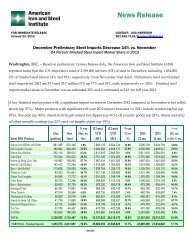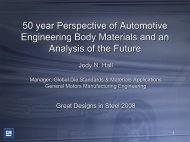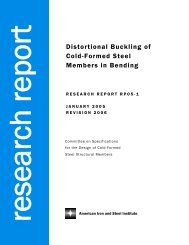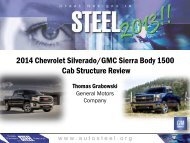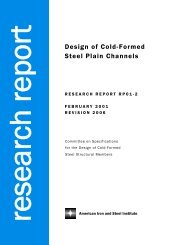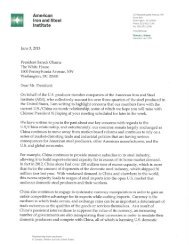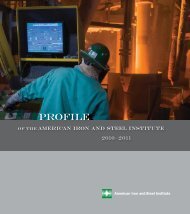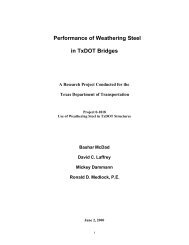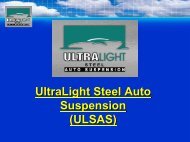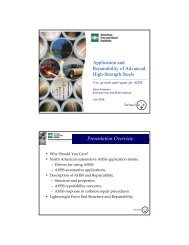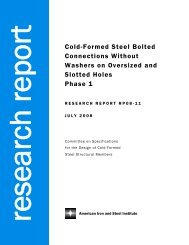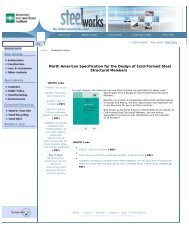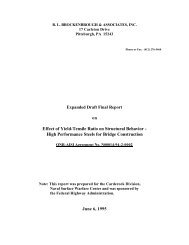Advanced High-Strength Steel Repairability Study: Phase I Final ...
Advanced High-Strength Steel Repairability Study: Phase I Final ...
Advanced High-Strength Steel Repairability Study: Phase I Final ...
Create successful ePaper yourself
Turn your PDF publications into a flip-book with our unique Google optimized e-Paper software.
General Motors-AISI AAC <strong>Advanced</strong> <strong>High</strong> <strong>Strength</strong> <strong>Steel</strong> <strong>Repairability</strong> <strong>Study</strong><br />
<strong>Phase</strong> I <strong>Final</strong> Report<br />
Introduction<br />
The introduction of <strong>Advanced</strong> <strong>High</strong> <strong>Strength</strong> <strong>Steel</strong>s (AHSS) to light vehicle body structure<br />
applications poses a significant challenge to organizations involved in the repair of vehicle<br />
structures. AHSS are typically produced by nontraditional thermal cycles and contain<br />
microstructural components whose mechanical properties can be altered by exposure to elevated<br />
temperatures. This temperature sensitivity could alter the mechanical behavior of AHSS after<br />
exposure to elevated temperatures during repair welding or flame straightening and could<br />
seriously affect the structural performance of AHSS components after repair. This study,<br />
requested by General Motors' Collision Repair Tech. Center, examined the mechanical behavior<br />
of two AHSS products, a 600 MPa tensile strength (TS) dual phase steel and a 1300 MPa TS<br />
Martensitic steel, after exposure to typical repair arc welding and flame straightening<br />
temperature cycles and developed recommended practices for repairing components made of<br />
these materials.<br />
This study is the first phase of and anticipated multi-phase effort to characterize AHSS and<br />
develop appropriate repair procedures for their various grades. <strong>Phase</strong> I objectives were to<br />
develop an appropriate method for characterizing the mechanical behavior of AHSS upon<br />
exposure to typical repair procedures and to develop recommendations for heat application<br />
during the repair of parts made from the dual phase and martensitic grades mentioned above.<br />
These AHSS grades are being specified for near-term General Motors vehicle platform<br />
components and require immediate repair procedure development. Subsequent phases of this<br />
activity will develop repair procedures for other AHSS grades as prioritized by General Motors<br />
or other auto OEM AHSS component introductions.<br />
<strong>Phase</strong> I was conducted by a team composed of General Motors, AISI, and AISI Automotive<br />
Applications Committee steel company representatives. Team members included:<br />
Member<br />
Brian Dotterer<br />
Jim Fekete<br />
David Anderson<br />
David Hoydick<br />
Steve Kelley<br />
Nassos Lazaridis<br />
Blake Zuidema<br />
Affiliation<br />
General Motors Corporation<br />
General Motors Corporation<br />
AISI (AISI Coordinator)<br />
United States <strong>Steel</strong> Corporation<br />
International <strong>Steel</strong> Group<br />
Ispat Inland, Inc.<br />
International <strong>Steel</strong> Group<br />
The results, conclusions, and recommendations contained herein are the consensus views of the<br />
team members.
Procedure<br />
Materials<br />
Conventional and AHSS steel grades selected for this study are as follows:<br />
<strong>Steel</strong> Grade<br />
GMW2M-ST-S Grade 4<br />
GMW3032M-ST-S CR340<br />
GMW3032M-ST-S CR 340 DP<br />
GMW3399M-ST-S 1300T/1030Y M<br />
Description<br />
Interstitial-Free HDGI-coated mild steel<br />
340 MPa yield strength HDGI-coated HSLA steel<br />
340 MPa YS, 600 MPa TS HDGI-coated DP steel<br />
1300 MPa TS cold rolled (bare) martensitic steel<br />
The interstitial-free (IF) mild and high strength, low alloy (HSLA) steels are conventional<br />
products that have been used in body structures for many years and are well known to be<br />
repairable without substantial structural performance degradation by arc welding and flame<br />
straightening. The mechanical property degradation exhibited by these materials defined a<br />
baseline against which the degradation of AHSS properties will be judged. The dual phase (DP)<br />
and martensitic (Mart) steels are AHSS grades used in structural applications on General Motors<br />
vehicles scheduled to launch in the near future, components for which valid repair techniques<br />
must be available. All steels were of approximately 1.5 mm gauge and were tested in the<br />
longitudinal direction.<br />
Vehicle Manufacturing Simulation<br />
The sheet steel comprising vehicle body structure components does not exist in its as-produced<br />
state at the time of repair, but rather has been subjected to several mechanical deformations and<br />
thermal treatments during stamping, assembly and painting, and subsequent damage. These<br />
treatments could alter the response of a component to subsequent repair processes. To simulate<br />
the actual state of material at the time of repair, the mild steel, HSLA, and DP steels were first<br />
subjected to 8% strain in uniaxial tension (to simulate part forming) and heated to 170 °C for 20<br />
minutes to simulate paint baking. Samples of DP600 steel were also subjected to the repair<br />
procedure thermal cycle in the as-received condition and with several combinations of low strain<br />
and paint bake. The martensitic steel was subjected only to the paint bake treatment, as<br />
martensitic steels rarely undergo substantial deformation during fabrication. All coated samples<br />
were stripped of zinc to prevent environmental problems during thermal treatment and testing.<br />
Simulated Repair Procedure Thermal Cycle<br />
Previous General Motors studies [1, 2] measured temperature histories at various distances from<br />
arc welds and flame straightening treatments on typical body structure components subjected to<br />
repair. A time-temperature test matrix was developed to represent the various thermal conditions<br />
encountered during repair welding and flame straightening, Table 1.
Table 1. Time-Temperature Test Matrix.<br />
Hold<br />
Hold Temperature (°C)<br />
Time (s) 650 750 850 1000<br />
5 X<br />
10 X X<br />
30 X X X X<br />
60 X X X<br />
90 X X<br />
Two additional cycles were simulated. Samples were heated to 750 °C for 90 seconds, with<br />
intermediate cooling briefly to below 538 °C after 30 and 60 seconds (to simulate multiple flame<br />
heating cycles). Samples of IF, HSLA, and DP without prestrain and paint baking (as-received<br />
condition) were subjected to the 650 °C, 90 second thermal treatment.<br />
Mechanical Testing<br />
Standard ASTM tensile tests were conducted of samples in the as-received condition, after<br />
straining and paint baking (baking only for the martensitic steel), and after the indicated thermal<br />
treatments. Results for two samples were averaged and yield strength (YS), ultimate tensile<br />
strength (UTS), uniform elongation (UEL), total elongation (TEL), and n-value were reported<br />
and plotted against temperature for each hold time. n-values were calculated in the 10% to end<br />
of uniform elongation strain range (YS to end of uniform elongation (~3% strain) for martensitic<br />
steel) The AC1 and AC3 temperatures (phase boundaries) for each steel grade were indicated on<br />
the property-temperature plots.<br />
Results and Discussion<br />
Interstitial-Free Grade 4 Mild <strong>Steel</strong><br />
Tensile test results for the Grade 4 IF mild steel are shown in Figures 1 through 5. Yield strength<br />
and TEL decreased slightly and USA and UEL increased slightly upon exposure to the lowest<br />
temperature thermal treatment, 650 °C. Yield strength and UTS monotonically decreased and<br />
UEL, TEL, and n-value monotonically increased upon exposure to all higher temperature<br />
thermal treatments. <strong>Strength</strong> remained above the as-received level at temperatures up to 850 °C,<br />
despite partial austenitization at 750 °C and 850 °C temperatures. There was no indication of<br />
embrittlement or significant loss in ductility at the 650 °C temperature. Only temperature<br />
affected mechanical properties; time at temperature had no significant effect.<br />
HSLA 340 <strong>Steel</strong><br />
Tensile test results for the HSLA 340 steel are shown in Figures 6 through 10. Yield and<br />
ultimate tensile strength decreased from initial strain plus age levels up to a thermal treatment of<br />
850 °C and then increased slightly at the highest thermal treatment, 1000 °C. UEL, TEL, and n-<br />
value all increased with increasing thermal treatment temperature up to 850 °C, and generally<br />
decreased as temperature increased thereafter to 1000 °C. <strong>Strength</strong> remained at or above as-
IF Grade 4 Mild <strong>Steel</strong><br />
400<br />
300<br />
200<br />
100<br />
0<br />
8% Strain + Bake<br />
As Received<br />
As Received + 650C/90s<br />
AC1 AC3<br />
0 200 400 600 800 1000 1200<br />
Hold Temperature, C<br />
5sec<br />
10sec<br />
30sec<br />
60sec<br />
90sec<br />
30x3sec<br />
Figure 1. Yield strength of IF Grade 4 mild steel after exposure to several simulated repair<br />
thermal cycles.<br />
IF Grade 4 Mild <strong>Steel</strong><br />
400<br />
300<br />
200<br />
100<br />
8% Strain + Bake<br />
As Received<br />
As Received +650C/90s<br />
5sec<br />
10sec<br />
30sec<br />
60sec<br />
90sec<br />
30x3sec<br />
0<br />
AC1<br />
AC3<br />
0 200 400 600 800 1000 1200<br />
Hold Temperature, C<br />
Figure 2. Ultimate tensile strength of IF Grade 4 mild steel after exposure to several simulated<br />
repair thermal cycles.
IF Grade 4 Mild <strong>Steel</strong><br />
30<br />
25<br />
20<br />
15<br />
10<br />
5<br />
As Received<br />
As Received + 650C/90s<br />
8% Strain + Bake<br />
5sec<br />
10sec<br />
30sec<br />
60sec<br />
90sec<br />
30x3sec<br />
0<br />
AC1<br />
AC3<br />
0 200 400 600 800 1000 1200<br />
Hold Temperature, C<br />
Figure 3. Uniform elongation of IF Grade 4 mild steel after exposure to several simulated repair<br />
thermal cycles.<br />
IF Grade 4 Mild <strong>Steel</strong><br />
50<br />
40<br />
30<br />
20<br />
10<br />
As Received<br />
As Received + 650C/90s<br />
8% Strain + Bake<br />
5sec<br />
10sec<br />
30sec<br />
60sec<br />
90sec<br />
30x3sec<br />
0<br />
AC1<br />
AC3<br />
0 200 400 600 800 1000 1200<br />
Hold Temperature, C<br />
Figure 4. Total elongation of IF Grade 4 mild steel after exposure to several simulated repair<br />
thermal cycles.
IF Grade 4 Mild <strong>Steel</strong><br />
0.25<br />
0.2<br />
0.15<br />
0.1<br />
0.05<br />
0<br />
As Received + 650C/90s<br />
As Received<br />
AC1 AC3<br />
0 200 400 600 800 1000 1200<br />
Hold Temperature, C<br />
5sec<br />
10sec<br />
30sec<br />
60sec<br />
90sec<br />
30x3sec<br />
Figure 5. n-value of IF Grade 4 mild steel after exposure to several simulated repair thermal<br />
cycles.<br />
HSLA 340 <strong>Steel</strong><br />
600<br />
500<br />
400<br />
300<br />
200<br />
100<br />
0<br />
8% Strain + Bake<br />
As Received + 650C/90s<br />
As Received<br />
AC1 AC3<br />
0 200 400 600 800 1000 1200<br />
Hold Temperature, C<br />
5sec<br />
10sec<br />
30sec<br />
60sec<br />
90sec<br />
30x3sec<br />
Figure 6. Yield strength of HSLA 340 steel after exposure to several simulated repair thermal<br />
cycles.
HSLA 340 <strong>Steel</strong><br />
600<br />
500<br />
400<br />
300<br />
200<br />
100<br />
0<br />
8% Strain + Bake<br />
As Received<br />
As Received + 650C/90s<br />
AC1 AC3<br />
0 200 400 600 800 1000 1200<br />
Hold Temperature, C<br />
5sec<br />
10sec<br />
30sec<br />
60sec<br />
90sec<br />
30x3sec<br />
Figure 7. Ultimate tensile strength of HSLA 340 steel after exposure to several simulated repair<br />
thermal cycles.<br />
HSLA 340 <strong>Steel</strong><br />
40<br />
35<br />
30<br />
25<br />
20<br />
15<br />
10<br />
5<br />
0<br />
As Received + 650C/90s<br />
As Received<br />
8% Strain + Bake AC1 AC3<br />
0 200 400 600 800 1000 1200<br />
Hold Temperature, C<br />
5sec<br />
10sec<br />
30sec<br />
60sec<br />
90sec<br />
30x3sec<br />
Figure 8. Uniform elongation of HSLA 340 steel after exposure to several simulated repair<br />
thermal cycles.
HSLA 340 <strong>Steel</strong><br />
40<br />
35<br />
30<br />
25<br />
20<br />
15<br />
10<br />
5<br />
0<br />
As Received<br />
As Received + 650C/90s<br />
8% Strain + Bake<br />
AC1 AC3<br />
0 200 400 600 800 1000 1200<br />
Hold Temperature, C<br />
5sec<br />
10sec<br />
30sec<br />
60sec<br />
90sec<br />
30x3sec<br />
Figure 9. Total elongation of HSLA 340 steel after exposure to several simulated repair thermal<br />
cycles.<br />
HSLA 340 <strong>Steel</strong><br />
0.2<br />
0.15<br />
0.1<br />
0.05<br />
0<br />
As Received + 650C/90s<br />
As Received<br />
8% Strain + Bake<br />
AC1 AC3<br />
0 200 400 600 800 1000 1200<br />
Hold Temperature, C<br />
5sec<br />
10sec<br />
30sec<br />
60sec<br />
90sec<br />
30x3sec<br />
Figure 10. n-value of HSLA 340 steel after exposure to several simulated repair thermal cycles.
eceived levels at temperatures up to 750 °C. There was no indication of embrittlement or<br />
significant loss of ductility at any test temperature. As with the mild steel, only temperature had<br />
a significant effect on mechanical properties; time at temperature had little effect.<br />
DP 600 <strong>Steel</strong><br />
Tensile test results for the DP 600 steel are shown in Figures 11 through 15. Yield and ultimate<br />
tensile strength both decreased after exposure to the lowest thermal treatment temperature, 650<br />
°C. Yield strength continued to decrease with exposure to higher temperatures, but the UTS<br />
increased substantially at the next higher temperature, 750 °C, then fell to an intermediate level<br />
at the highest thermal treatment temperatures. Ultimate tensile strength fell slightly below the<br />
as-received level when subjected to the 650 °C treatment. Yield strength remained above asreceived<br />
levels at the 650 °C and 750 °C thermal treatment temperatures. Elongation and n-<br />
value generally increased with increasing thermal treatment temperature. There was no<br />
indication of embrittlement or substantial loss of ductility at any thermal treatment temperature.<br />
As with the two previous steels, the DP 600 steel was sensitive only to temperature; time at<br />
temperature had little effect on mechanical properties.<br />
When the DP 600 steel in the As Received condition (without the 8% prestrain plus paint bake<br />
thermal treatment) was exposed to the 650 °C/90 second simulated repair thermal cycle,<br />
substantial degradation in ultimate tensile strength was noted. UTS dropped from 642 to 515<br />
MPa, a decline of 20% and well below the 600 MPa minimum UTS specified for this grade. YS<br />
and n-value were unchanged, and elongation improved slightly from the as-received condition.<br />
The drop in UTS is of substantial concern in crash performance. Dual phase steels are used<br />
increasingly in crashworthiness-critical auto body structural components because its high UTS<br />
for a given YS provides much greater energy absorption than in conventional HSS. Many<br />
structural components contain large areas with little or no strain imparted by the forming<br />
process, and these areas do not benefit from strain hardening and age hardening. The<br />
degradation in UTS from exposure to the repair thermal cycle could substantially reduce the<br />
ability of such components to absorb crash energy. Additional tests were performed on As<br />
Received DP 600 samples that were subjected to just the paint bake thermal cycle, and to a 1/2%<br />
uniaxial tensile prestrain plus the paint bake cycle to determine if low levels of strain and age<br />
hardening are sufficient to offset the strength loss from exposure to the repair thermal cycle in<br />
DP 600 components with little or no forming strain. Results of these supplemental tests and<br />
those of pertinent initial tests are listed in Table 2.<br />
Table 2. Supplemental tensile tests of DP 600 steel.<br />
Test Condition<br />
YS<br />
(MPa)<br />
UTS<br />
(MPa)<br />
TEL<br />
(%)<br />
UEL<br />
(%)<br />
n-value<br />
(4-6%)<br />
n-value<br />
(10-UEL) YPE<br />
As Received (AR) 404 642 26 16 0.18 0.14 0.0<br />
AR+650 °C/90sec 412 515 30 18 0.21 0.16 2.8<br />
AR+Bake+650 °C/90sec 419 526 28 16 0.20 0.16 2.6<br />
AR+1/2%ε + Bake 471 658 25 16 0.16 0.15 0.0<br />
AR+1/2%ε + Bake + 650 °C/90sec 427 527 27 16 0.20 0.16 2.8<br />
AR+8%ε + Bake 658 683 15 4 n/a n/a 0.0<br />
AR+8%ε + Bake + 650 °C/90sec 550 610 22 11 0.13 0.11 3.5
Clearly, bake hardening and low levels of strain plus bake hardening are insufficient to offset the<br />
UTS loss due to exposure to the lowest temperature repair thermal cycle in DP 600 steel.<br />
Structural components of this grade with low levels of forming strain will likely exhibit UTS<br />
well below the specified 600 MPa minimum UTS for DP 600.<br />
Structure evolution in the DP 600 steel was studied by metallography. Figures 16 through 18<br />
show the microstructure of the DP 600 steel in the As Received, As Received + 8% Strain + 650<br />
°C/60s, and As Received + 8% Strain + 750 °C/90s conditions, respectively, after etching in<br />
LePera' etchant. LePera's etchant stains the ferrite phase a light gray color and leaves<br />
untempered martensite white. The 650 °C/60s thermal treatment substantially tempered the<br />
martensite phase, as indicated by darkening of the martensite phase in Figure 17. The 750<br />
°C/90s thermal treatment heated the steel back in to the ferrite plus austenite phase field and reformed<br />
fresh untempered martensite, as indicated by the return of the light colored phase in<br />
Figure 18.<br />
1300 MPa UTS Martensitic <strong>Steel</strong><br />
Tensile test results for the 1300 MPa UTS martensite steel are shown in Figures 19 through 22.<br />
Martensitic steels generally exhibit very little uniform elongation; only total elongation is shown<br />
here. Yield and ultimate tensile strength were substantially reduced by all thermal treatments,<br />
falling to about half their as-received level at the lowest thermal treatment temperature, 650 °C.<br />
The loss in strength was accompanied by a rapid increase in elongation and n-value, particularly<br />
as temperature entered the two-phase region (above AC1 temperature). There was, however, no<br />
substantial embrittlement noted at any thermal treatment temperature.<br />
General Observations<br />
The IF mild and HSLA 340 materials are conventional steels, both relying on various<br />
combinations of grain size, solute, and precipitation strengthening to attain their requisite<br />
mechanical properties. These strengthening mechanisms are generally insensitive to exposure to<br />
temperatures below the two-phase region for short times. In this study, these conventional steels<br />
exhibited only slight decrease in strength upon exposure to the subcritical thermal treatment<br />
temperature, 650 °C. <strong>Strength</strong> decrease in these cases is attributed to recovery of the cold work<br />
imparted by the simulated forming step, slight grain coarsening, and in the case of the HSLA<br />
steel, coarsening of the strengthening precipitates. <strong>High</strong>er thermal treatment temperatures<br />
caused these steels to enter or exceed the two-phase region, resulting in greater strength<br />
reductions due to recrystallization and grain growth. It was encouraging to find that these steels<br />
were not embrittled by exposure to temperatures just below the two-phase region (the so-called<br />
blue brittleness effect). This result is consistent with previous GM work [1, 2].<br />
The DP 600 steel is strengthened largely by the presence of islands of hard martensite in a soft<br />
ferrite matrix. <strong>Strength</strong>ening is a function of both the volume fraction of martensite and the<br />
strength of the martensite phase. Prior to this study, concerns had been raised that exposure to
temperatures high in the subcritical region would over-temper the martensite phase and<br />
substantially reduce the strength of the DP 600 steel. This study confirmed that strength loss<br />
upon exposure of the DP 600 steel to the 650 °C thermal treatment temperature was more<br />
significant than that of the conventional steel.<br />
A 20% reduction in ultimate tensile strength was observed DP 600 samples subjected to the 650<br />
°C thermal treatment. <strong>Strength</strong> decrease in this material is attributed to two major factors -<br />
tempering of the martensite and recovery of cold work from the simulated forming operation.<br />
The ferrite in the DP 600 steel contained a much greater amount of cold work before the thermal<br />
treatment, (strain is concentrated in the softer ferrite phase) and driving force for recovery was<br />
much greater. <strong>Strength</strong> loss due to recovery is expected to be greater than that exhibited by the<br />
HSLA 340 steel. Furthermore, in this study, effects of strength loss due to recovery cannot be<br />
separated from those due to martensite tempering. For the DP 600 steel, the combined effects can<br />
be sufficient to reduce UTS to substantially below the 600 MPa UTS minimum for the grade,<br />
particularly in part regions that are not strained significantly by the press forming operation, and<br />
degrade structural performance. These data indicate that the DP600 should not be repaired by<br />
flame straightening or be exposed to heat during repair.<br />
The 1300 MPa UTS martensitic steel is strengthened by transformation to almost 100% volume<br />
fraction martensite. This steel was expected to exhibit significant strength loss due to tempering<br />
of the martensite by the repair thermal treatments. Indeed, this study confirmed that exposure to<br />
even the lowest welding and thermal straightening thermal treatments substantially degraded<br />
mechanical properties. These results indicate that 1300 MPa UTS martensitic steel components<br />
should not be welded or flame straightened in any manner, but be replaced in entirety if<br />
necessitated by repair requirements. This precaution can be extended to cover all martensitic<br />
grade steel components.<br />
The Mild and HSLA 340 steels also exhibited slight changes in mechanical properties upon<br />
exposure to the 650 °C thermal cycle. These changes could affect fatigue endurance, particularly<br />
in the case of UTS reduction. However, other durability degradations introduced by the damage<br />
and repair processes themselves are felt to be of a much greater magnitude, however, and<br />
durability degradation due to a slight reduction in fatigue endurance is not felt to be a significant<br />
consideration.<br />
The lowest thermal treatment (650 °C) employed by this study is tolerated by the mild and<br />
HSLA steels. This temperature is consistent with GM's currently recommended repair<br />
temperature range, up to 1200 °F (650 °C - note that GM's current repair policy references<br />
temperature in °F). This temperature is also practical to sense with the unaided eye - repair<br />
technicians need only keep the heat below a dull cherry red color to stay within the<br />
recommended temperature range.<br />
GM Position on <strong>Repairability</strong> of the Subject <strong>Steel</strong> Grades<br />
Per GM service policies, mild steel (including interstitial-free steel), high-strength-low-alloy<br />
steel (HSLA), high tensile strength steel (HSS) and bake hardenable steel are considered<br />
repairable after a collision. The policy supplies recommendations for the use of heat in collision
epair. The recommendation limits the maximum temperature to 1200 °F (650 °C), and the<br />
heating time to 90 seconds. The heating can be performed two times if needed. The purpose of<br />
this study was to re-validate these recommendations for today’s steels, and to begin evaluating<br />
repairability of advanced high strength steels (AHSS)<br />
The results shown here indicate that heat can be used in repair procedures for IF steel<br />
(GM6409M, GMW2M) and 340 MPa minimum yield strength HSLA (GM6208M, GM6218M,<br />
GMW3032M). The limitation that temperature must not exceed 1200 °F (650 °C) for a<br />
maximum of two cycles of 90 seconds each should remain in force. The maximum temperature<br />
is the most important factor affecting mechanical property degradation; time at temperature did<br />
not have a significant effect on properties at the times and temperatures studied. The data also<br />
shows that following the recommended repair thermal treatment limitations should not cause<br />
embrittlement or significant loss of ductility in the tested materials.<br />
These results also show that heat is not recommended for repair of dual phase materials<br />
(GMW3032M, GMW3399M). These results show that as-received DP steels with minimum<br />
tensile strength values of 600MPa experience a 20% drop in TS after the application of 650 °C.<br />
Strain and bake hardening response does not counteract this behavior.<br />
Results for the 190 KSI (1300 MPa) minimum tensile strength product (GM6123M) reinforce<br />
the previously drawn conclusion that martensitic products of this strength level must not be<br />
repaired. The only available repair procedure is removal and replacement.<br />
Future Work<br />
The industry is moving rapidly towards implementing AHSS materials with even higher strength<br />
levels than the 600 MPa minimum ultimate tensile strength dual phase steel studied in these<br />
experiments. Therefore, there is an urgent need to expand the range of materials tested here to<br />
include DP 780, DP 980 and TRIP steel in the range of 600 to 800 MPa TS.<br />
There is also a need to evaluate the combination of heat application and welding during collision<br />
repair on the properties of high strength steels and advanced high strength steels. This is critical<br />
because if heat cannot be used for straightening operations, there will be an additional reliance<br />
on sectioning and welding techniques for repair of components made from AHSS materials.<br />
Further collaborative work should be focused on these two objectives. <strong>Phase</strong> II of this study will<br />
address both.
DP 600 <strong>Steel</strong><br />
800<br />
600<br />
400<br />
200<br />
0<br />
8% Strain + Bake<br />
As Received + 650C/90s<br />
As Received<br />
AC1 AC3<br />
0 200 400 600 800 1000 1200<br />
Hold Temperature, C<br />
5sec<br />
10sec<br />
30sec<br />
60sec<br />
90sec<br />
30x3sec<br />
Figure 11. Yield strength of DP 600 steel after exposure to several simulated repair thermal<br />
cycles.<br />
DP 600 <strong>Steel</strong><br />
800<br />
600<br />
400<br />
200<br />
0<br />
8% Strain + Bake<br />
As Received<br />
As Received + 650C/90s<br />
AC1 AC3<br />
0 200 400 600 800 1000 1200<br />
Hold Temperature, C<br />
5sec<br />
10sec<br />
30sec<br />
60sec<br />
90sec<br />
30x3sec<br />
Figure 12. Ultimate tensile strength of DP 600 steel after exposure to several simulated repair<br />
thermal cycles.
DP 600 <strong>Steel</strong><br />
30<br />
25<br />
20<br />
15<br />
10<br />
5<br />
0<br />
As Received + 650C/90s<br />
As Received<br />
8% Strain + Bake AC1 AC3<br />
0 200 400 600 800 1000 1200<br />
Hold Temperature, C<br />
5sec<br />
10sec<br />
30sec<br />
60sec<br />
90sec<br />
30x3sec<br />
Figure 13. Uniform elongation of DP 600 steel after exposure to several simulated repair thermal<br />
cycles.<br />
DP 600 <strong>Steel</strong><br />
30<br />
25<br />
20<br />
15<br />
10<br />
5<br />
0<br />
As Received + 650C/90s<br />
As Received<br />
8% Strain + Bake<br />
AC1 AC3<br />
0 200 400 600 800 1000 1200<br />
Hold Temperature, C<br />
5sec<br />
10sec<br />
30sec<br />
60sec<br />
90sec<br />
30x3sec<br />
Figure 14. Total elongation of DP 600 steel after exposure to several simulated repair thermal<br />
cycles.
DP 600 <strong>Steel</strong><br />
0.2<br />
0.15<br />
0.1<br />
0.05<br />
As Received + 650C/90s<br />
As Received<br />
5sec<br />
10sec<br />
30sec<br />
60sec<br />
90sec<br />
30x3sec<br />
0<br />
AC1<br />
AC3<br />
0 200 400 600 800 1000 1200<br />
Hold Temperature, C<br />
Figure 15. n-value of DP 600 steel after exposure to several simulated repair thermal cycles.
Figure 16. Microstructure of DP 600 steel in the As Received condition. LePera's etch, 1000X.<br />
Figure 17. Microstructure of DP 600 steel after 8% strain in uniaxial tension, paint baking, and<br />
exposure to 650 C for 60 seconds. LePera's etch, 1000X.<br />
Figure 18. Microstructure of DP 600 steel after 8% strain in uniaxial tension, paint baking, and<br />
exposure to 650 C for 90 seconds. LePera's etch, 1000X.
1300 MPa UTS Martensitic <strong>Steel</strong><br />
1600<br />
1400<br />
1200<br />
1000<br />
800<br />
600<br />
400<br />
200<br />
0<br />
Bake<br />
As Received<br />
AC1 AC3<br />
0 200 400 600 800 1000 1200<br />
Hold Temperature, C<br />
5sec<br />
10sec<br />
30sec<br />
60sec<br />
90sec<br />
30x3sec<br />
Figure 19. Yield strength of 1300 MPa martensitic steel after exposure to several simulated<br />
repair thermal cycles.<br />
1300 MPa UTS Martensitic <strong>Steel</strong><br />
1600<br />
1400<br />
1200<br />
1000<br />
800<br />
600<br />
400<br />
200<br />
0<br />
Bake<br />
As Received<br />
AC1 AC3<br />
0 200 400 600 800 1000 1200<br />
Hold Temperature, C<br />
5sec<br />
10sec<br />
30sec<br />
60sec<br />
90sec<br />
30x3sec<br />
Figure 20. Ultimate tensile strength of 1300 MPa martensitic steel after exposure to several<br />
simulated repair thermal cycles.
1300 MPA UTS Martensitic <strong>Steel</strong><br />
40<br />
35<br />
30<br />
25<br />
20<br />
15<br />
10<br />
5<br />
0<br />
As Received<br />
Bake AC1 AC3<br />
0 200 400 600 800 1000 1200<br />
Hold Temperature, C<br />
5sec<br />
10sec<br />
30sec<br />
60sec<br />
90sec<br />
30x3sec<br />
Figure 21. Total elongation of 1300 MPa martensitic steel after exposure to several simulated<br />
repair thermal cycles.<br />
1300 MPa UTS Martensitic <strong>Steel</strong><br />
0.25<br />
0.2<br />
0.15<br />
0.1<br />
0.05<br />
0<br />
As Received<br />
Bake<br />
AC1 AC3<br />
0 200 400 600 800 1000 1200<br />
Hold Temperature, C<br />
5sec<br />
10sec<br />
30sec<br />
60sec<br />
90sec<br />
30x3sec<br />
Figure 22. n-value of 1300 MPa martensitic steel after exposure to several simulated repair<br />
thermal cycles.
Conclusions<br />
1. The mechanical properties of IF grade 4 mild and HSLA 340 do not degrade substantially<br />
upon exposure to temperatures of up to 650 °C (1200°F), for short duration.<br />
2. The mechanical properties of the DP 600 and 1300 MPa UTS martensitic steels were<br />
substantially degraded by exposure to 650 °C (1200°F) for any duration.<br />
3. Exposure to 650 °C (1200°F) did not significantly embrittle any steel tested in this study.<br />
4. Degradations of fatigue performance introduced by exposure of the steels tested to 650 °C<br />
(1200 °F) for short duration should not be significant compared to degradations introduced<br />
by the damage and subsequent repair processes themselves.<br />
5. Temperature was the most significant factor affecting mechanical properties of the mild,<br />
HSLA, and DP; properties were not significantly influenced by time at temperature.<br />
6. Structural components made of mild, bake hardenable, solid solution-strengthened, and high<br />
strength low alloy, can be repaired by arc welding or flame straightening processes provided<br />
that the maximum temperature does not exceed 650 °C (1200 °F) for more than two cycles of<br />
90 seconds each.<br />
7. Structural components made of DP 600 and of martensitic steel of any strength should not be<br />
repaired by application of heat (flame straightening), but replaced in entirety.<br />
Recommendation<br />
Following the results of <strong>Phase</strong> I of this study, the GM repair matrix is updated according to the<br />
recommendation below. In this update, consideration is given to higher strength grades of dual<br />
phase steel and other AHSS types referenced by GMW3399M-ST-S, grades that may be of<br />
interest in future studies.<br />
Recommended GM <strong>Steel</strong> <strong>Repairability</strong> Matrix<br />
Grade Repairable Use of Heat Temp. Range Maximum Heat<br />
Mild <strong>Steel</strong> Yes Yes Up to 1200 °F 90 sec. x 2<br />
(650 °C)<br />
Bake Hardenable Yes Yes Up to 1200 °F 90 sec. x 2<br />
(650 °C)<br />
Solid Solution- Yes Yes Up to 1200 °F 90 sec. x 2<br />
<strong>Strength</strong>ened<br />
(650 °C)<br />
<strong>High</strong> <strong>Strength</strong>, Yes Yes Up to 1200F 90 sec. x 2<br />
Low Alloy<br />
(650 °C)<br />
Dual <strong>Phase</strong><br />
TBD No N/A N/A<br />
600 MPa UTS<br />
TRIP TBD TBD TBD TBD<br />
Martensitic No No N/A N/A
References<br />
1. E. G. Brewer, K. Malstrom, R. Stevenson, and H. D. Pursel, "Effect of Simulated Repair<br />
Heat Treatments on the Physical Properties of <strong>High</strong> <strong>Strength</strong> <strong>Steel</strong>s," General Motors<br />
Corporation Research Report No. PH-1251, August 9, 1985.<br />
2. R. Stevenson, E. G. Brewer, K. Malstrom, and H. D. Pursel, "Effect of Simulated Repair<br />
Heat Treatments on the Physical Properties of <strong>High</strong> <strong>Strength</strong> <strong>Steel</strong>s," SAE Technnical Paper<br />
No. 910292, SAE, Warrendale, PA, 1991.



